There are 9 types of turtles in Maine, 7 native species as well as 2 common varieties of sea turtle species that frequently appear in nearby coastal waters. The more common species native to Maine are Painted turtles, Snapping turtles, and Musk turtles.
However, some native species are threatened, including Blanding’s turtles and Eastern Box turtles, while species like Wood turtles and Spotted turtles are cause for ecological concern. Here’s our guide to the native turtles in Maine.
Table of Contents
Turtles in Maine
1. Blandings Turtle
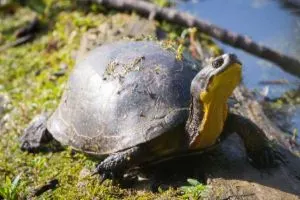
- Experience Level: Intermediate
- Family: Emydidae
- Scientific Name: Emydoidea Blandingii
- Adult Size: Between 5 and 8 inches
- Lifespan: Up to 80 years
- Average price range: Between $300 and $450
Named after naturalist William Blanding, these turtles have dark oval shells with yellow speckling. Their plastrons are yellow with black patches. Blanding’s turtles are a characterful species also known as “the turtle that smiles”.
Blanding’s turtles are an endangered species in Maine. Populations have been dispersed by threats to their preferred marshy habitats. They are cautious, often diving to safety or retracting into their shells at any sign of trouble.
Blanding’s turtles are omnivorous, mainly eating crayfish, earthworms, and water-borne insects. They also occasionally eat plants, and unusually among turtles they do not rely on water to help them swallow.
2. Eastern Box Turtle
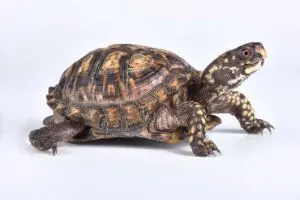
- Experience Level: Beginner
- Family: Emydidae
- Scientific Name: Terrapene Carolina Carolina
- Adult Size: Between 4 and 7 inches
- Lifespan: Up to 40 years
- Average price range: Between $120 and $400
- Recommended books: Box Turtles: Complete Herp Care by Tess Cook
Eastern Box turtles are another threatened species native to Maine. They have distinct yellow and orange markings on their thick domed dark brown shells. Their plastrons are also dark brown. Uniquely, Eastern Box turtles can regenerate their shells.
These terrestrial turtles can roam up to 50 meters a day in search of food. Eastern Box turtles are omnivores will eat fish and invertebrates as well as plants.
Eastern Box turtles prefer woodland as well as marshy and grassland areas. They have a home territory of around 230 meters and live near streams and ponds.
3. Common Musk Turtle
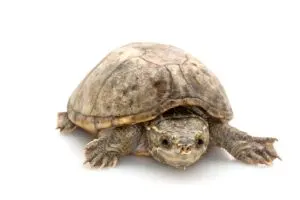
- Experience Level: Intermediate
- Family: Kinosternidae
- Scientific Name: Sternotherus Odoratus
- Adult Size: Between 4 and 5 inches
- Lifespan: 50 years and over
- Average price range: Between $20 and $90
- Where to buy: theturtlesource.com, undergroundreptiles.com
Eastern Musk turtles are also known as “Stinkpots” and the common musk turtle due to the strong smell they can release from their musk glands, which they use to protect themselves from predators. They are relatively common throughout Maine.
Eastern Musk turtles have dark, unmarked shells. Their heads are also dark, with yellow lines along their faces. They prefer marshy and boggy habitats.
An omnivorous species, Eastern Musk turtles hunt for prey by scent. They mainly eat mollusks, crayfish, small fish, and tadpoles. They aren’t strong swimmers, so do not really chase prey.
4. Common Snapping Turtle

- Experience Level: Intermediate to Expert
- Family: Chelydridae
- Scientific Name: Chelydra Serpentina
- Adult Size: Between 8 and 20 inches
- Lifespan: Between 30 and 50 years
- Average price range: Between $20 and $40
- Recommended books: Snapping Turtle Pet Owners Guide (Ben Team)
The largest amphibious turtles native to Maine, Common Snappers can be found around large bodies of water. They can be aggressive and will often hiss and bite. They do not bask often, preferring to remain in the water.
Identified by their distinctive hooked “beaks”, Common Snappers usually have dark brown or green shells. They also have relatively strong claws and long tails that sport saw-toothed ridges.
Common Snappers are nocturnal omnivores, mainly eating fish and other aquatic prey. They also consume underwater vegetation. There have been some instances of Snappers eating small waterbirds if they get close enough.
5. Painted Turtle
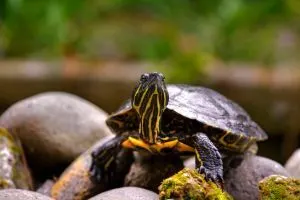
- Experience Level: Beginner
- Family: Emydidae
- Scientific Name: Chrysemys Picta
- Adult Size: Between 4 and 10 inches
- Lifespan: Between 30 and 50 years
- Average price range: Between $20 and $50
- Recommended books: Painted Turtle Pet Owners Guide by Ben Team
Two Painted turtle subspecies are native to Maine: the Eastern Painted and the Midland Painted. A popular species of turtle to keep as a pet, Painted turtles have dark shells with faint yellow stripe markings.
Eastern Painted turtles have plastrons ranging from orange to red, with black and yellow patterning. Midland Painted turtles can be distinguished by a dark, shadow-like patch in the center of their plastrons.
Mainly an aquatic species, Painted turtles stay near the water and like to bask. Painted turtles are omnivorous and mainly eat mollusks, frogs, and underwater invertebrates. They must swallow food in the water.
6. Spotted Turtle
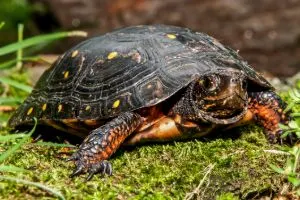
- Experience Level: Intermediate to Expert
- Family: Emydidae
- Scientific Name: Clemmys Guttata
- Adult Size: Between 4 and 5 inches
- Lifespan: Between 25 and 50 years
- Average price range: Between $75 and $100
- Recommended books: BASICS – Ecology, Husbandry & Breeding Spotted & Wood Turtles by Andreas S. Hennig
Spotted turtles are a small, beautiful species. Their smooth shells are black, covered with their eponymous bright yellow dots. Their plastrons are yellow with large black patches of varying sizes on either side.
These semi-aquatic turtles prefer shallower waters alongside marshy and boggy habitats. Spotted turtles like to bask, often perching themselves on logs by the water.
This omnivorous species often eats invertebrates, crustaceans, mollusks as well as vegetation. Their small size makes them great pets. They are considered a species of concern in Maine, and are very sensitive to local water pollution.
7. Wood Turtle
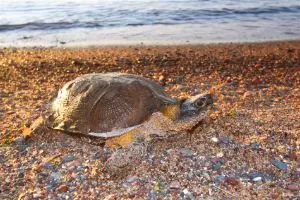
- Experience Level: Intermediate
- Family: Emydidae
- Scientific Name: Glyptemys Insculpta
- Adult Size: Between 5 ½ to 8 inches
- Lifespan: 40 years in the wild, 58 years in captivity
- Average price range: Between $249 and $495
- Recommended books: Wood Turtles: A Pet Care Guide for Wood Turtles by Lolly Brown
Wood turtles are an intelligent species, but their conservation status in Maine is concerning. Their main habitats are woodlands and ponds.
They are active during the day and roam widely while looking for food. They are omnivores and often eat berries, plants, mollusks and earthworms. They can rock themselves to create vibrations in the soil, fooling worms into thinking it’s raining.
Wood turtles are named because of their shells, which are rough and feel like they’re made of wood. Their patterning looks similar to growth rings and wood grain. They are mostly brown in color.
Sea Turtles In Maine
There are also two species of sea turtles that regularly visit the waters around Maine. They are the Ridley sea turtle and the leatherback turtle. Both species are endangered. While they cannot be kept as pets, here are some facts about these marine species.
8. Kemp’s Ridley Sea Turtle
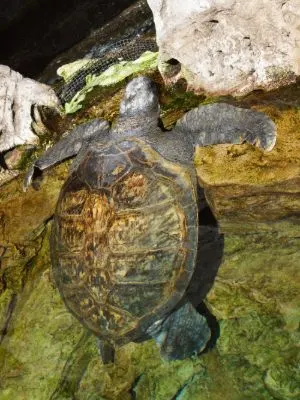
- Family: Cheloniidae
- Scientific Name: Lepidochelys Kempii
- Adult Size: Around 25 inches
- Weight: Between 75 and 100 lbs
- Lifespan: Around 30 years
- Conservation Status: Critically Endangered
- Habitat: Sandy or muddy coastlines with shallow waters
- Clutch Size: Between 100 and 110 eggs, 2 to 3 clutches per breeding season
- Food: Crustaceans, shellfish
- Appearance: Slightly hooked beaks, triangle-shaped heads. Green to gray round shells. Muted cream or yellow plastrons and undersides.
Check out our Ridley sea turtle page for more information.
9. Leatherback Sea Turtle

- Family: Dermochelyidea
- Scientific Name: Dermochelys Coriacea
- Adult Size: Between 6 and 7 feet
- Weight: Between 1200 and 1450 lbs
- Lifespan: Around 30 years
- Conservation Status: Vulnerable
- Habitat: Warm waters, mainly shallow, calm bays or lagoons. Nests common on sandy beaches.
- Clutch Size: Between 100 and 110 eggs
- Food: Jellyfish is the staple of their diet, but they will also eat other sea creatures
- Appearance: Their large carapaces are soft, unique among sea turtles, with prominent ridges all the way down. Colors vary between black and a dark gray.
For more information, see our Leatherback sea turtle page.
Conclusion
The 9 species covered here are all native to Maine and vary from common turtles like the Common Snapping turtle, Eastern Musk turtles, and Painted turtles, to threatened or endangered species like the Blanding’s turtle or Wood turtle.
We’ve also covered two species of sea turtle that are frequent visitors to the coastal waters of Maine, the Ridley’s sea turtle and the leatherback sea turtle.
Did you enjoy this article? Feel free to comment below!
Other nearby states
- Turtles in Europe
- Turtles in Massachusetts
- Turtles in New Hampshire
- Turtles in Rhode Island
- Turtles in Vermont
